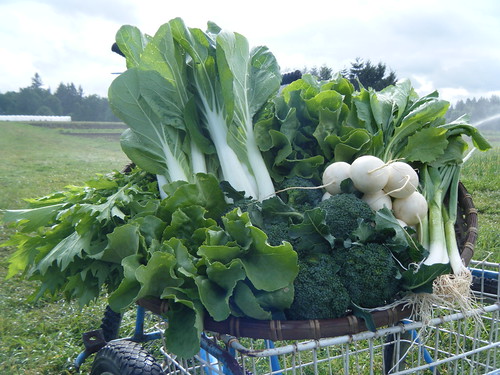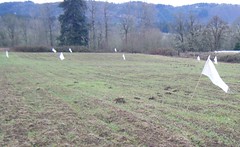This Week’s Share
- Broccoli
- Carrots
- Fennel
- Garlic Scapes
- Kale, Red Ursa
- Lettuce
- Onions, Siskiyou Sweets
- Spinach
Recipes
Note: Remember to check out Chef’s Corner for recipes using Carrots, Sweet Onions, and Spinach in the Week 5 blog post.
Broccoli Recipes
Curried Broccoli Soup
From the City Gardeners Cookbook
1 tablespoon butter
¾ cups onion, chopped
2 garlic scapes, minced
¾ teaspoon curry powder
1/8 teaspoon freshly ground pepper
2 cups vegetable stock
4 cups broccoli, chopped
1½ cups potatoes, cubed
1 cup milk
In a soup kettle melt butter and sauté onions and garlic until tender. Add curry powder, pepper, stock, and 2/3 cup water; bring to a boil. Stir in broccoli and potatoes. When mixture returns to boil, reduce heat, cover, and simmer until vegetables are tender, about 20 minutes. Puree soup (if desired) in batches in food processor. Return puree to soup kettle, stir in milk and heat slowly. Makes 6 servings.
Pasta with Broccoli Florets
From Madison Area CSA Coalition
2 to 4 cups broccoli florets (you decide how much broccoli you want in your pasta)
½ pound pasta
2 tablespoons olive oil
2 tablespoons butter
1 to 2 garlic scapes, minced
½ pounds mushrooms (whole, halved, or sliced)
¼ cup grated Parmesan cheese
Cook broccoli florets in boiling water 2 to 3 minutes. Remove with slotted spoon. Cook pasta in same water (or use fresh if you prefer). Meanwhile, heat olive oil and butter in a skillet. Saute garlic and mushrooms 3 to 4 minutes. Stir in broccoli. Drain pasta. Toss with broccoli and cheese. Makes 2 to 4 servings.
Fennel Recipes
Portobello Mushrooms Stuffed with Spinach, Parmesan, and Fennel
Adapted from Food to Live By by Myra Goodman
4 large Portobello mushroom caps (about 1½ pounds total)
¼ cup olive oil, plus more for oiling the baking dish
½ cup onion, finely minced
1½ cups fennel, finely minced
4 garlic scapes, finely minced (or 4 cloves of garlic)
6 ounces shiitake mushrooms, stems discarded, caps minced (about 1 cup)
12 ounces spinach, cut into ribbons (about 8 cups)
¼ cup fresh flat leaf parsley, minced
3 tablespoons fresh tarragon, minced
1 ¼ cups freshly grated Parmesan cheese
Salt and freshly ground black pepper, to taste
Wipe the Portobello mushroom caps clean with a damp towel. Using a paring knife or teaspoon, remove the gills to create a shallow depression for the stuffing. Place the portobellos on the lightly oiled baking dish and set aside. Position the rack in the center of the oven and preheat oven to 400˚F.
Heat the olive oil in a large skillet over medium-low heat. Add the onions and fennel and cook until soft, 8 to 10 minutes. Add the garlic scapes and shitake mushrooms and cook until the moisture has evaporated, about 10 minutes. Stir in the spinach and cook until it wilts, about 5 minutes, working in batches, in necessary. Add the parsley, tarragon, and ½-cup of Parmesan cheese and stir to combine. Cook until the cheese melts, about 1 minute. Season the filling with salt and pepper to taste.
Spoon the filling into the portobellos, mounding it slightly. Sprinkle 3 tablespoons of the remaining Parmesan cheese over each mushroom. (The mushrooms can be prepared up to this stage 4 hours ahead. Refrigerate them, covered until ready to bake). Bake the mushrooms until they are tender but not soggy and the cheese on the top has browned, 20 to 25 minutes. Serve immediately. Serves 4.
Fennel and Sweet Onion Salad
By Francesca Benedetti, CSA Coordinator at SIO
Note: The amount you use of each item (aside from the fennel) is up to you and your taste preference. I like to go heavy on everything because I like things with a lot flavor.
2 bulbs of fennel with tops, thinly sliced
½ to 1 sweet onion, thinly sliced
1 to 2 tablespoons olive oil
2 to 3 tablespoon fresh lemon juice
¼ to ½ cup shaved or shredded Parmesan cheese
Sea salt and freshly ground black pepper, to taste
Thinly slice the fennel, including the bulb and the stalk portion of the tops and place in medium size bowl. Reserve 1/3 to ½ of the fronds for later use. Thinly slice the sweet onion and add to the bowl. Chop up the reserved fennel fronds and add to the bowl. Add in the lemon juice, Parmesan cheese, and sea salt and pepper to taste. Toss everything together until evenly combined and let stand for at least 15-30 minutes (or up to 24 hours) before serving.
Spinach Recipe
Portobello Mushrooms Stuffed with Spinach, Parmesan, and Fennel
(see above in Fennel Recipes)




















